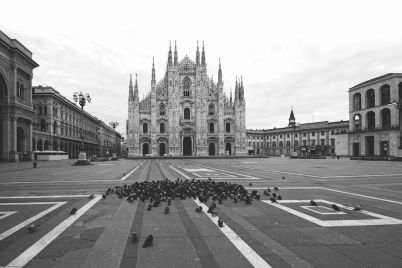During this extraordinary and unsettling time, I have found my mind wandering to the rituals and activities that give me comfort and connect me to my past. In particular, this past summer, I was drawn to the routine and rhythm of gardening. I crave a sense of normalcy, a return to a simpler life, a connection to nature and to my past. The garden became my refuge from the daily onslaught of disturbing and conflict-ridden news reports. It also provided me with purpose, beauty, distraction and comfort, reminding me of my youth, my parents and a time that seems idyllic today. Writing this story about my mother’s garden gave me a sense of peace and hope.
A soft, gentle breeze caressed the northern garden, causing the stalks of camomile to sway gracefully against the setting sun. The apples on the trees glistened, cherry-red orbs reflecting the sun’s rays. A diminutive figure dressed in black carefully pulled the weeds winding around the mint plants. She observed the parade of squirrels, crows and woodpeckers that often frequented the garden, fascinated by their ritual while ruing their intrusion into her life. Slowly the woman turned and walked back to the house, having completed her daily tasks. She had carefully tended the plants, coaxing them to grow, and foraged in the garden as she did as a young girl in the village of Grimaldi, Cosenza, Italy. Antonietta cast a last lingering look at the garden illuminated by the rosy hues of the fading sun and entered the house.
Who was this tiny figure amidst the apple trees? It was my mother, Antonietta. She was born in Grimaldi, a picturesque village nestled in the rolling hills of Southern Italy, not far from the village of Aiello Calabro, the birthplace of her future husband, Gaspare. Her father Antonio was a landowner in the village, and her mother Maria Rosa was a skilled seamstress. Her father died young, leaving Maria Rosa to face the daunting prospect of raising her young family alone. Her small family depended on the ancestral land and a network of relatives to carve out a living through farming and the exchange of labour for goods. They survived by enacting the concept of arrangiarsi, eking out a living through being resourceful and adaptable when tending the land, particularly in the face of difficult circumstances.
The garden and the land played a prominent role throughout her long life. Indeed, her garden reflected the different stages of her life; young girl, wife, mother, grandmother and great-grandmother. The garden embodied the beliefs that were forged by the experiences of her youth; family, patience, optimism, resourcefulness, hard work and respect for the land. In Italy, the land gave Antonietta’s family some measure of independence and dignity. Antonietta believed that the land had a life force that was transmitted to the crops. The longer a plant was in the soil, the more nutritious it became. The land could also be capricious and unyielding; when one crop failed it was necessary to make do by growing another. Antonietta worked the ancestral farmland with her mother and brother, Giuseppe, walking two hours to and from the property each day. They cultivated a variety of crops, and picked fresh cherries and figs to eat along the way. When there was an overabundance of crops, they were sold in the village market. Everything else was consumed at the family table or preserved for future use. Through hard work and resourcefulness in the cultivation of their land, her family was able to survive.

Antonietta awaiting departure from Italy to Port Arthur (ON) in 1954.
It was difficult to find work in the post-war Italy of the 1950s. The lure of steady work in Canada for Antonietta’s brother Giuseppe prompted the family’s chain migration to the small town of Port Arthur, Ontario, Canada. Giuseppe left their village in 1953, and worked building and maintaining rail lines with the R.F. Welch Company in Northwestern Ontario. He then called for Maria Rosa and Antonietta to join him, and they departed from Naples, navigating choppy seas and finally arriving at Pier 21 in Halifax. After an exhausting journey by train from Halifax to Montreal, and then Montreal to Port Arthur, Maria Rosa and Antonietta arrived in their new hometown. They were welcomed and supported by a network of relatives and paesani from Grimaldi. Antonietta never returned to her beloved village, although she remembered it with affection. She looked forward to her new life in Canada where her family was now re-united.
It was in Port Arthur that Antonietta met Gaspare, her future husband, when he was a boarder in her cousin’s home. After a short courtship, Antonietta and Gaspare were married and moved into their first home. Her first three children were born in quick succession. Antonietta was busy tending to both her family and the boarders who rented rooms in her house upon their arrival in Canada from Italy.
One day, while walking near her home, she noticed a familiar plant growing on the boulevard. Camomile had taken root in the grass; the seeds had blown over the fence of an Italian neighbour. Antonietta quickly plucked the camomile from the boulevard and planted it in her garden. She shared the plant with her growing family in Canada, and transplanted it to each of her subsequent homes in Port Arthur. In her first home, she used a camomile infusion to treat colicky children, and to nurse her mother to health when she was ill. The plant was a welcome reminder of home, and Antonietta realized that it had many uses for her growing family.
In Canada, both new and familiar crops were coaxed from the frigid northern climate. Antonietta and Gaspare made extraordinary efforts to extend the short growing season, and to protect the seedlings as they grew to maturity and were harvested. In the late spring they carefully planted seeds harvested from the previous year to grow starter plants for the garden. After the frost was gone, they planted the seedlings, and grew fruits and vegetables reminiscent of the crops they grew in Italy: fava beans, zucchini, onions, garlic, oregano, basil, flat-leaf parsley, cucumbers and tomatoes. The harvest was enjoyed fresh, and preserved in a number of different ways to see them through the cold winter months.
In Italy, they had foraged for wild oregano, fennel, or chicory, and picked plums and cherries fresh from the trees. In Canada, Antonietta and Gaspare took advantage of food in the natural environment – foraging for mushrooms and hunting in the fall, and picking blueberries in the summer. The children were recruited to help with cleaning the freshly-picked mushrooms, picking beans in the garden, and shelling peas. They also helped with the canning and preserving that occurred at the picnic table in the back yard.
Antonietta and Gaspare replicated and adapted the seasonal calendar of southern Italy to the cold winter climate of Port Arthur. During the months of January and February, they were busy making sausages and capicolli that would be enjoyed throughout the year. The spring and summer were consumed with planting, tending and harvesting the garden. In the fall, they purchased Roma tomatoes and canned them to make the tomato sauce that dressed pasta, risotto, and various other dishes. At harvest time, they purchased grapes and made wine in the fashion of their ancestors, using a winepress to extract the juice and fermenting the wine in barrels, finally bottling it in demi-johns. Cases of olives were depitted and soaked in water to remove their bitterness, anointed with olive oil and aromatic garlic, and placed in jars.
The riserva or cantina (cold room or cellar) was the repository for many of the items carefully preserved to last the long winter. A well-stocked riserva provided a measure of security for the rest of the year. Mason jars full of tomato sauce, olives, pickled vegetables, and fruit preserves glistened in the chiaroscuro of the riserva. Sausages hung from the ceiling as they cured to perfection. Demi-johns of wine were carefully covered with cloths, and ceramic urns contained vegetables preserved under salt. These seasonal practices were instrumental to their survival in Italy, but became cherished traditions in their new homeland. When they were not successful in growing familiar plants in the garden, they planted them in pots inside the house. The ubiquitous fig tree grew indoors, and evoked the nostalgia of picking wild figs under the Mediterranean sun and drying them. Ornamental orange trees yielded tiny fruits that were used to flavour cookies and cakes.
When her husband Gaspare became ill, Antonietta continued to work in the garden. She harvested the fresh fruits and vegetables to nourish her ailing husband. A warm cup of camomile tea often soothed him and helped him to sleep. When he succumbed to his illness, Antonietta relied on the rituals of preparing, planting, nurturing and harvesting the garden to give her life a comforting and familiar rhythm.
Well into her eighties, Antonietta worked in her garden, although it was much smaller. Her garden had been vast and substantial, but it now lay fallow. For the most part, she harvested perennial plants that optimistically popped up in the snow-dotted spring garden. As Antonietta aged, her garden seemed to mirror her increasing frailty. The sturdy camomile plants became spindly, the mint grew in patches and the raspberries were barely visible through the overgrown trees. Nevertheless, she persisted in weeding and watering with her favourite tapered watering can, strategically located in the closet by the back door.
The apple trees were now intertwined in a graceful canopy and provided endless amusement for her grandchildren and great-grandchildren. They frolicked under the shade of apple trees, and marvelled at their height. Sometimes they climbed the trees, much to Antonietta’s chagrin, as she was a careful and cautious nonna. They picked raspberries from the growing patch, and ate the juicy morsels straight from the spiny stems.
Although her gait was laboured and her vision cloudy, she continued her life-long relationship with the land and the stocking of her larder, in anticipation of the long, cold winter ahead. The garden was a constant, yet evolving presence in her life. The life force contained in the soil sustained Antonietta through her struggle for survival in Italy. As she lovingly tended the land and reaped its harvest, she supported her young family and nourished her ailing relatives. Working in the garden, touching the soil, and coaxing the plants to grow, she felt her spirit and her strength renew. She cast a last long look at the garden and sighed with satisfaction, knowing that her work was done for the day. Tomorrow the routine would begin anew.
Antonietta passed away in 2019 after a lifetime of caring for her family. When her house was sold, we visited the garden for the last time, much as one would make a pilgrimage to a sacred place. I felt her spirit everywhere. The garden was overgrown and patchy, but in my mind, I could see her bent over the copious camomile and mint plants, carefully selecting the most robust stalks and placing them in a basket for future use. As I now work in my much smaller garden, I put my hands in the soil and feel the life force that she always invoked. I understand her fierce attachment to the land and her garden, and the gifts that they yielded during her life. Similarly, my urban garden has become a gift, an elixir, a refuge and a source of comfort and sustenance for my family in difficult times.
Dr. Frances Garofalo is a former superintendent of education, author, artist, photographer and researcher. She is currently researching the role of women in the post-war immigration process to Canada. She lives in Thunder Bay, Ontario.



